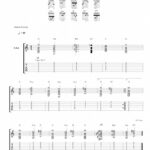So, you’re restringing your guitar? It’s a fundamental part of guitar maintenance, but are you doing it correctly? Many guitar players, even experienced ones, unknowingly string their guitars in a way that can cause significant damage over time. The biggest culprit is incorrect stringing technique, which can lead to wear and tear on your guitar’s bridge plate, a crucial component located beneath the bridge inside the guitar. Learning How Do I String A Guitar properly isn’t just about getting your instrument playable; it’s about protecting its longevity and sound quality.
Why Correct Stringing Matters: Protecting Your Bridge Plate
The bridge plate, typically made of rosewood or maple, is designed to withstand the tension of the strings. It acts as an anchor, preventing the ball ends of the strings from ripping through the softer spruce top of your guitar. However, incorrect stringing can turn the string windings into tiny saws, gradually carving grooves into this essential plate.
Imagine forcing the string ball end into the bridge hole with the bridge pin and then pulling upwards to seat it. This action, repeated every time you change strings, grinds away at the bridge plate. Similarly, if the ball end isn’t seated parallel to the guitar body, it can also cause uneven wear. Over time, this damage can become so severe that the windings of the strings may even protrude through the bridge, signaling the need for an expensive repair. A damaged bridge plate can cost upwards of $100 to repair – a cost entirely avoidable with proper stringing technique.
The good news? Stringing your guitar correctly is simple and takes only a few extra moments. By adopting the right method, you can ensure your bridge plate remains in excellent condition for decades, safeguarding your guitar’s structural integrity and sound.
Step-by-Step Guide: Stringing Your Guitar the Right Way
Follow these steps to string your guitar correctly and protect your bridge plate from unnecessary wear:
-
Prepare Your Workspace and Gather Your Tools: You’ll need your new strings, a string winder (optional but highly recommended), and potentially a pair of wire cutters. A small mirror can also be helpful to inspect the bridge plate (like the one shown below).
-
Bending the String (Slightly): Before inserting the string, create a gentle bend in the ball end of the string. This slight curve helps to position the ball end correctly against the bridge plate. Avoid kinking the string; a gentle bend is all you need.
-
Inserting the Ball End Correctly: Insert the ball end of the string into the bridge hole. The key here is to ensure the ball end is oriented parallel to the guitar body as you push it in. Push the ball end in until it’s firmly against the bridge plate before inserting the bridge pin. When correctly inserted, the ball end should curl towards the soundhole and disappear from view slightly. Hold the ball end in place against the plate.
-
Securing with the Bridge Pin: Now, insert the bridge pin to secure the string. Ensure you keep your bridge pins in order if you are changing all strings at once, so you can put them back in their original holes.
-
Determining the Correct String Length at the Tuning Peg: To get the right length for winding around the tuning peg, pull the string up to its corresponding tuner. Hold the string at the tuner post with your left hand. With your right hand, pinch the string at the 3rd fret and pull it up to the 5th fret, allowing slack to slide through your left fingers. Cut the string at the point where your left-hand fingers are holding it at the tuner post. This method provides the ideal length for proper winding. Repeat this for each string.
-
Winding the String on the Tuning Peg: Insert the string end into the tuning peg hole and begin to wind. Use a string winder to speed up this process. Crucially, ensure the string winds underneath itself on the tuning peg. This creates a secure and neat winding.
-
Check Ball End Seating: Before bringing the string to full tension, take a moment to check that the ball end is still seated correctly and parallel against the bridge plate. This is a good practice for each string as you install it.
-
Tune and Stretch: Once all strings are installed, tune your guitar to pitch and stretch the strings by gently pulling them away from the body. Retune as needed until the strings hold their pitch.
Recognize the Damage: What Incorrect Stringing Does
Incorrect stringing, over time, leads to visible damage to the bridge plate. Look out for these signs:
- Worn Bridge Plate Holes: Enlarged or elongated holes in the bridge plate.
- Torn Grain: Splintering or tearing of the wood around the string holes on the bridge plate.
- String Windings Protruding: Seeing the windings of the string ends becoming visible on top of the bridge, getting closer to the saddle, is a clear indicator of bridge plate wear.
This image shows the kind of damage you want to avoid:
Stringing it Right for the Long Run
Mastering how do i string a guitar correctly is a small investment of time that pays off significantly in the long run. By following these steps, you’ll protect your guitar’s bridge plate, avoid unnecessary repairs, and ensure your instrument remains in top playing condition for years to come. Happy stringing!

